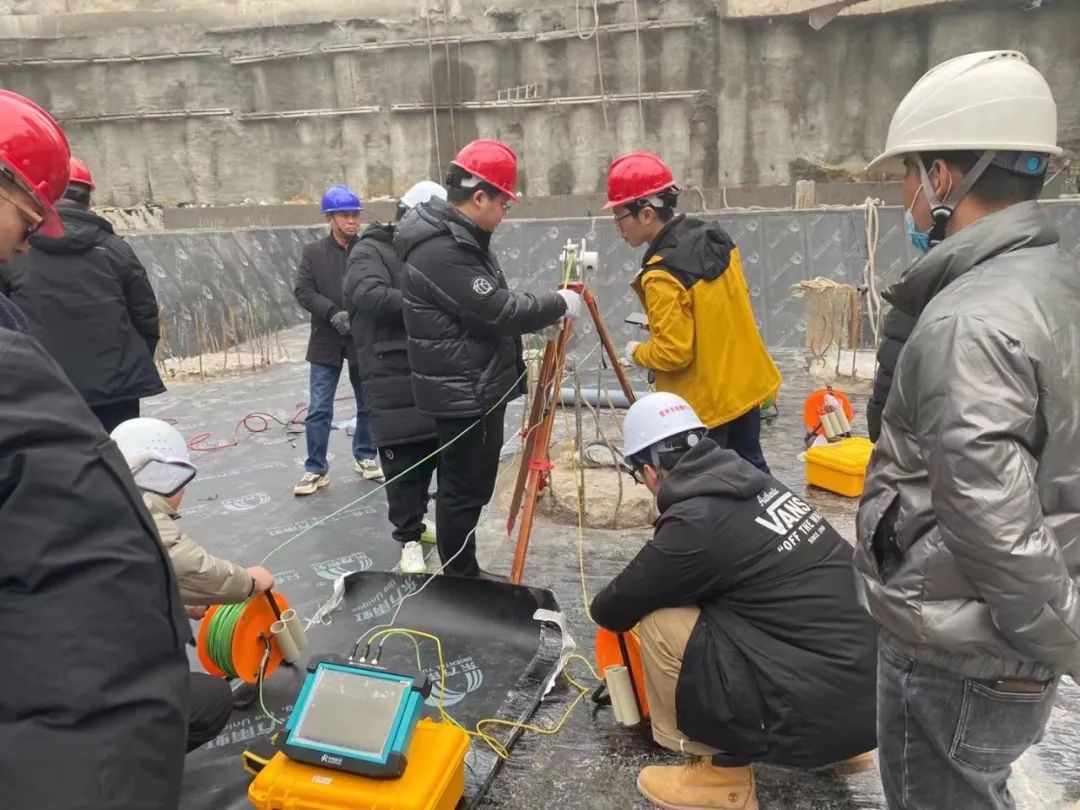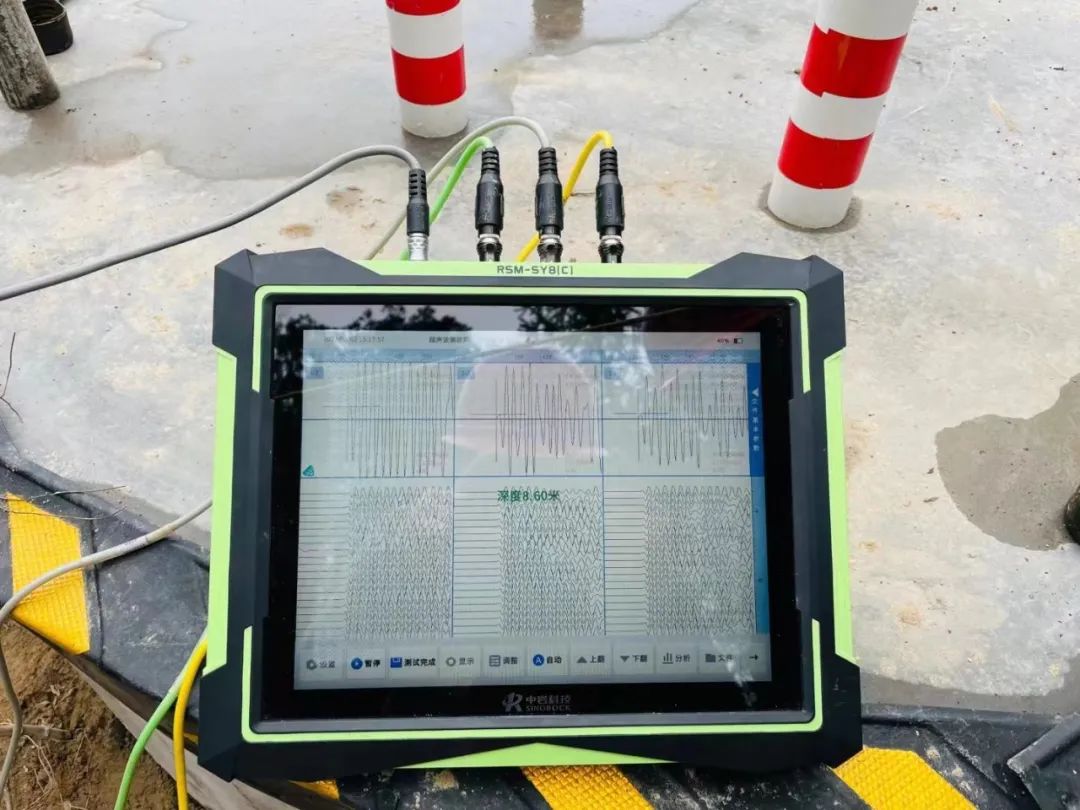Abstract:The acoustic transmission method for detecting the integrity of foundation piles is a relatively mature detection technology. This paper introduces the principle, testing method and judgment basis of crosshole sonic logging method. Combined with the author's years of engineering practice and testing examples, it classifies the main defect types of foundation piles, and summarizes the matters needing attention in field testing and data analysis.
Brief introduction of pile testing by acoustic transmission method
In modern engineering construction, the pile foundation that transfers the load to the stable deep soil is an economic and safe foundation engineering with mature construction technology. Its quality will directly affect the bearing capacity and service life of the structure. Among the existing pile integrity detection methods, the acoustic transmission method has good accuracy, high detection efficiency, mature technology and is widely used.

Pile measurement by acoustic transmission method
Principle and method of pile testing by acoustic transmission method
1. Principle
When ultrasonic wave propagates in concrete and encounters defects, such as cracks, mud inclusions, cavities, honeycombs, looseness, low strength or uneven aggregate, the sound wave will be diffracted, refracted and reflected, which will generally cause energy attenuation, sound time increase, sound velocity decrease, wave amplitude decrease and waveform distortion.
The sonic logging method to detect the integrity of pile concrete is based on the change of acoustic parameters. The steel pipe is fixed inside the reinforcement cage of the foundation pile as the channel of the acoustic transducer; Fill the test tube with clean water as couplant before testing; The transducer is placed in the test tube, the transmitting transducer emits multi frequency pulse ultrasonic waves according to a certain period, and the receiving transducer converts the received sound waves into electrical signals, which are amplified, stored, processed by the sound meter and analyzed by special software. According to the changes of acoustic parameters and other factors, the pile concrete is comprehensively judged to determine its integrity.

2. Scope of application
The CSL method is generally applicable to the cast-in-place pile with a pile diameter greater than 0.8m. When the pile diameter is less than 0.8m, the coupling between the acoustic transducer and the pipe will cause a large relative test error; When the pipe spacing is greater than a certain length, the accumulated minor defects will affect the judgment of the foundation pile. The pile length is unlimited, and the form can be round pile or square pile; The construction process can be manual hole digging or mechanical punching. The stress type of foundation pile can be end bearing pile or friction pile, anti-slide pile or structural stress pile.
3. Mode
According to the embedment of the test pipe, the detection methods are divided into cross hole detection, single hole detection and out of pile detection.
(1) Cross hole inspection. The transmitting and receiving transducers are respectively placed in two measuring tubes. According to the relative height difference between the two transducers, horizontal measurement, oblique measurement, sector scanning measurement and other methods are adopted.
(2) Single hole inspection. Single hole detection is to connect the transmitting and receiving transducers together through sound insulation materials and place them in the same hole. The sound wave is diffracted through water coupling agent and concrete medium, analyze the received sound wave and judge the concrete quality around the hole. (3) Outside pile inspection. The detection outside the pile is to place a low-frequency emission flat probe with strong power on the top of the foundation pile, and drill a hole outside the foundation pile as the receiving transducer channel. The sound wave passes through the concrete, the soil between the pile and the test hole, and the receiving transducer receives various acoustic parameters as the basis for analysis and judgment. Note: the commonly used detection method is cross hole detection, and single hole and out of pile detection are rarely used at present.
4. Determination of pile integrity
(1) Sound velocity criterion
The sound velocity is the most stable and reliable, but there is no specific quantitative formula to express the relationship between the sound velocity and strength of all concrete at present. Only the sound velocity can be used to compare the quality of concrete under the same conditions. When the measured sound velocity is lower than the critical value of sound velocity determined by mathematical statistical probability, it is regarded as a suspicious defect point.
(2) Acoustic frequency
When the sound wave encounters concrete defects, the attenuation is serious and the dominant frequency is significantly reduced, which indirectly reflects the quality of concrete. However, the comparability of different sections and different foundation piles is not strong, and it is only applicable to the relative comparison of various measuring points in the same section. Therefore, the main frequency change is only used as an auxiliary judgment.
(3) Amplitude criterion
Wave amplitude is an important parameter to characterize the energy attenuation degree of sound wave passing through concrete. The amplitude is not as stable as sound velocity and dominant frequency, but it is more sensitive to defective concrete. Due to the influence of many factors, it is only used for relative comparison under the same conditions. When the measured amplitude is lower than the critical value of the amplitude, it is regarded as a suspicious defect area.
(4) Acoustic wave form
Waveform is the overall reflection of sound energy. During detection, in addition to reading the sound time and amplitude of sound wave point by point, attention should also be paid to observing the change of the whole waveform as an important reference for comprehensive judgment.
(5) PSD criterion
The PSD value of the product of the slope on the sound time depth curve and the change of sound time is used as the criterion for outliers. According to the sudden change of PSD value at a certain depth and the changes of other acoustic parameters, the abnormal points are determined.
According to the above criteria, the integrity of the foundation pile is comprehensively judged. Comprehensive judgment: firstly, analyze the measuring points and areas where the wave velocity and amplitude are obviously low, and determine the abnormal position in combination with PSD criterion. Secondly, conduct detailed measurement for suspicious points.
Engineering application
According to the type of foundation pile, pile forming method and construction technology, the defects of foundation pile can be roughly divided into the following reasons:
1. Manual hole digging and pouring of ordinary concrete
① Affected by groundwater scouring
An ordinary concrete foundation pile with manual hole digging is located on the river beach. The cement slurry is completely washed away by the underground flowing water, and the sand and gravel are completely dispersed; It causes the attenuation of regional wave velocity and amplitude, and the sudden change of PSD criterion; The test conclusion is verified by drilling core samples.
② Sundries in concrete
For a manually excavated ordinary concrete foundation pile, the cement bag is wrapped in the concrete, and the concrete wrapped in the cement bag is very dense, resulting in obvious attenuation of wave velocity and amplitude in the defect area.
2. Mechanical hole forming and underwater concrete pouring
① Pile bottom sediment
When cleaning the hole at the bottom of a mechanical bored underwater concrete foundation pile, the sediment was not cleaned, resulting in the simultaneous attenuation of the wave velocity and amplitude at the bottom of the pile; Through core drilling, it is verified that there is sediment at the pile bottom.
② Mud inclusion
For a mechanical bored underwater concrete foundation pile, the tremie was lifted too fast when pouring concrete, and the retaining wall slurry was mixed with the concrete to form a broken pile; The wave velocity attenuation of each section on the waveform is obvious, the wave amplitude has no significant change, and the PSD criterion is abrupt; Through core drilling, it is found that the concrete is mixed with mud.
③ Concrete segregation
Due to the segregation of concrete, there are more coarse mortar and less aggregate in a mechanical bored underwater concrete pile. It is found that the wave velocity of each section of the foundation pile decreases significantly, but the wave amplitude attenuation is not significant; Through drilling core samples and core concrete compressive strength test, the concrete segregation is verified, and the concrete strength is lower than the design strength.
Experience
1. Before inspection, the type of foundation pile, geological survey and construction technology shall be mainly understood; In particular: whether there is a pause of more than 30min during concrete pouring; If it is a punching underwater concrete foundation pile, whether the tremie is leaked, whether the pipe is blocked and whether the hole at the pile bottom is cleaned; If it is an ordinary concrete foundation pile with manual hole digging, whether there is groundwater, the location and flow of groundwater, whether it is flowing water and the treatment of groundwater.
2. The interval from pile forming to detection should meet the specification requirements, because the wave velocity error is large before the concrete is completely hardened; After the concrete is hardened, the compactness is greatly improved and the waveform curve is greatly developed.
3. If the acoustic pipe is covered with mud, it is often misjudged as a layered defect. The specific location and area of the defect can be determined by oblique measurement.
